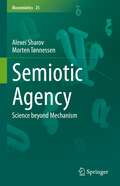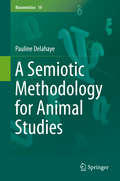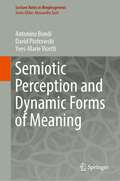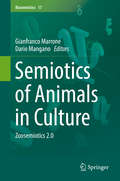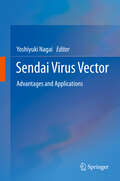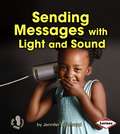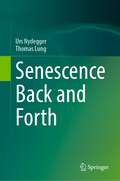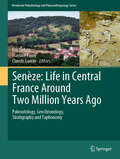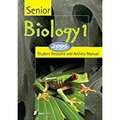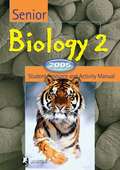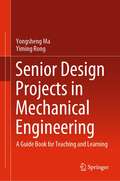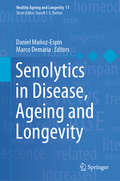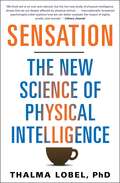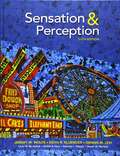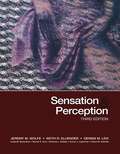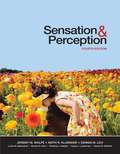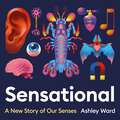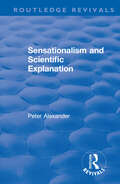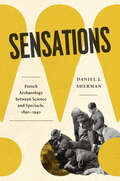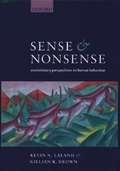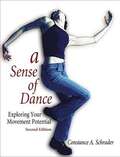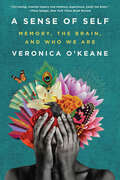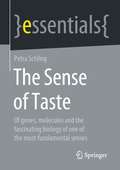- Table View
- List View
Semiotic Agency: Science beyond Mechanism (Biosemiotics #25)
by Alexei Sharov Morten TønnessenThis book invites readers to embark on a journey into the world of agency encompassing humans, other organisms, cells, intracellular molecular agents, colonies, populations, ecological systems, and artificial autonomous systems. We combine mechanistic and non-mechanistic approaches in the analysis of the function and evolution of organisms, their subagents, and multi-organism systems, and in this way offer a theoretical platform for integrating biosemiotics with both natural science and the humanities/social sciences. Agents are autonomous systems that incorporate knowledge on how to make sense of their environment and use it to achieve their goals. The functions of all agents are supported by mechanisms at the lowest level; however, the explanatory power of mechanistic analysis is not sufficient for complex agents. Non-mechanistic methods rely on the goal-directedness of agents whose dynamics follow self-stabilized dynamic attractors. The properties of attractors depend on stable or slowly changing factors, and such dependencies can be interpreted as sign relations if they are adaptive in nature. Agents can replace or redirect mechanisms on demand in order to preserve their functions; for performing higher-level semiotic functions, mechanisms are thus only means. We assume that mechanism and semiosis are not mutually exclusive, and that simple agents can interpret signs mechanistically. This assumption allows us to extend semiotic analysis to all agents, including ribosomes in cells, computers, and robots. This book challenges established traditions in natural science and the humanities/social sciences: semiotics no longer appears as restricted to humans and rational thinking, and biology is no longer limited to rely exclusively on mechanistic reasoning.
A Semiotic Methodology for Animal Studies (Biosemiotics #19)
by Pauline DelahayeThis monograph is about new perspective in animal studies methodology, by using concepts and tools from the field of semiotics. It proposes a reflexion on current challenges and issues in the ethology field, and introduces different semiotics – biosemiotics, zoosemiotics – as potential methodological solutions. The chapters cover many aspects of ethology where semiotics can be a helpful hand: studies of language, culture, cognition or emotions, issues about complex, endangered or variable species. It explains why these points are difficult to study for actual ethology, why they still matter for researchers, biodiversity actors or wildlife programs, and how an interdisciplinary study with a semiotic point of view can help understand them. This book will appeal to a wide readership, from researchers and academics in living sciences as well as in linguistics fields, to other professionals – veterinarian, wildlife managers, zookeepers, and many others – who feel the need to better understand some aspects of animals they are working with. Students with animal focus should read this book as an introduction to interdisciplinary methodology, and a proposition to work differently with animals.
Semiotic Perception and Dynamic Forms of Meaning (Lecture Notes in Morphogenesis)
by Antonino Bondi David Piotrowski Yves-Marie VisettiWhat do we mean by semiotic perception? Why should the concepts of perception and expressivity be reinterpreted within the encompassing framework of a dynamic theory of semiotic fields and forms? Can we redeploy the concept of form in such a way as to make explicit such a native solidarity (‘chiasmatic’ would have said Merleau-Ponty) between perception, praxis and expression -- and first and foremost in the activity of language, right to the heart of the life of the social and speaking animal that we are? What then would be the epistemological and ontological consequences, and how might this affect the way we describe semiolinguistic forms? This book aims to provide answers to these questions by opening up avenues of research on how to understand the linguistic and semiotic dimensions at work in the constitution of experience, both individual and collective.
Semiotics of Animals in Culture: Zoosemiotics 2. 0 (Biosemiotics Ser. #17)
by Gianfranco Marrone Dario ManganoTo place animals within the realm of nature, means inserting them among the articulations of culture and the social. Semiotics has never avoided this chiasmus, choosing to deal from the outset with the problem of the languages of animals following the old admonition of Montaigne: it is not that animals do not talk, it is us who do not understand them.Recent research in the field of the anthropology of nature and sociology of sciences and techniques allow to think about the Zoosemiotic issue in a different way. Instead of transplanting the language structures – gestures, LIS, etc. – for a semiotic study of the forms of the human and social meaning, it seems more apt to look at their discourse, and as such, the actual interactions, communicative and scientific as well as practical and functional, between humans and non-humans. This book aims to investigate precisely this hypothesis, known here as Zoosemiotics 2.0, working on several fronts and levels:· Anthropology· Languages of the image and visual representations, from art history to cinema· Old and new media. From literature to comics, from cartoons to TV documentaries but also advertising, music, Web and social networks. All those cultural products that talk about the role of human and non-human in society implicitly proposing (and in some way imposing) a form of articulation of such a relationship.· Food and feeding rites· Animalist, vegetarian and vegan movements · Philosophy: metaphysics, ethics, aesthetics
Sendai Virus Vector
by Yoshiyuki NagaiSendai virus (SeV) is not just a mouse pathogen but is evolving into a cutting-edge component of biotechnology. SeV reverse genetics originating from a pure academic need to settle long-held questions in the biology and pathogenicity of nonsegmented negative strand RNA viruses (Mononegavirales) is about to bear the impressive fruit of multipurpose cytoplasmic (non-integrating) RNA vectors. This book brings together in one source the SeV biology revealed by conventional approaches and reverse genetics, the methods to construct the first-generation SeV vector and to generate safer versions, and the applications in medical settings that have left or are about to leave the laboratory bench. The applications, which already are diverse and have high medical impact, include use as vaccine vectors against AIDS and respiratory virus infections, creation of BioKnife to resect malignant tumors, induction of "footprint (transgene) free" pluripotent stem cells, and gene therapy for peripheral arterial disease. These achievements--which are just a few of many examples--were attainable only after rigorously incorporating the rich knowledge of SeV biology that has accumulated during the several decades since the discovery of the virus. Application of SeV vector is certain to expand greatly because of its extremely high performance in transgene expression and its remarkable target cell breadth.
Sending Messages with Light and Sound
by Jennifer BoothroydYoung readers will learn how we send and receive messages using light and sound in this accessible, photo-filled book. Simple text explains different methods of sending messages and shows how light and sound make sending these messages possible. Vibrant photos bring basic science concepts to life and encourage kids to explore light and sound on their own.
Sending Signals (Smithsonian Science Stories)
by Life ReaderLet in the Light, Sensible Structures, Seeing with Sound, Animals with something to say, Life as an Animal behavior Scientist, Seeking The Sun, Faster than a Flying Pigeon, Living light Bulbs.
Senescence Back and Forth
by Urs Nydegger Thomas LungThis book is about lifelong ageing of humans. The basic biochemical and genetic mechanisms remain ill known, and differ among individuals. The book starts out to explore the plant and animal kingdoms to answer questions human ageing needs for understanding. First, we come to scrutinize time running out and what ‘normal’ means with impacts on the genome and on protein half- lives and function. Ageing goes beyond biochemical skid treated by geroprotector drugs, including biosimilars; albeit early diagnosis with standard medical laboratory assays, here addressed, sheds light with focus on basic research. Modern tools, including machine learning, and DNA technology, e.g. genomics, have already provided for unanticipated insights. The chapters then turn around senescence of the entire organism based on variable ageing of single organs embedded in neuronal networks . Psychological stress factors, dementia opposed to vigilance, and distinction of ageing from overt disease are contrasting in humans and are opposed in the book. Senescence, seen as a one way track may be reverted into rejuvenation, made possible by insights into immunosenescence and genomic approaches. Risk management in health insurance finds important clues in this book. The topics addressed between the book covers help to understand the trend to the ever- prolonging life expectancy beyond the centenarian age group; nursing care takers and pharmaceutical industry are invited to understand what’ is going on in senior people to make their geriatric population remain fit or become frail.
Senèze: Paleontology, Geochronology, Stratigraphy and Taphonomy (Vertebrate Paleobiology and Paleoanthropology)
by Eric Delson Martine Faure Claude GuérinThe paleontological site of Senèze (Haute Loire, central France) was discovered in 1892 inside a volcanic crater. For over 40 years, local peasant Pierre Philis collected fossils and sold them to French and Swiss museums. The site became world-famous for its well-preserved skeletons of ungulates and carnivores, as well as rare but well-preserved remains of primates and other mammals. It is considered the reference fauna for the late Villafranchian and MNQ 18 biochronological units of European mammalian evolution, but the lack of provenance data made modern research difficult. From 2000-2006, the multidisciplinary Franco-American Senèze Research Project undertook five seasons of major fieldwork, with the goals of clarifying the age, stratigraphy and taphonomy of Senèze, as well as finding additional remains, especially of the less well-known taxa. In this volume, following a history of study and summary of the new fieldwork, four geological chapters consider field methods, stratigraphy, volcanology and dating. Combining argon-argon ages and paleomagnetic calibration, the newly recovered fossils are shown to date between 2.20 and 2.08 Ma, with concentrations ca. 2.20-2.18 and 2.10-2.08 Ma, significantly older than previously thought. Chapters on palynology, ichthyology and ornithology are followed by eight chapters on the fossil mammals. The chapter on biochronology places Senèze among other sites at the start of MNQ 18, which is estimated to end ca. 1.7 Ma. Of some 2200 specimens known from the site, over half are cervids, with bovids, rhinocerotids and equids far behind. According to data from palynology and the habitat preferences of the more common mammals, the paleoenvironment around the Senèze maar would have included forest, woodland and grassland, perhaps in a warmer and moister climate than today. Taphonomic studies revealed that bones often rested a long time under water, lacked any indication of carnivore attack and often displayed pathologies in their joints. It is likely that most of the associated skeletons were preserved undisturbed after large mammals fell into the paleolake and drowned without being able to climb out. This book responds to the long-held desire of later Cenozoic paleontologists to see a modern study of a site recognized worldwide as a biochronologic reference for the Plio-Pleistocene. Our study required renewed fieldwork using up to date techniques of topography, sedimentology, stratigraphy, geochronology and taphonomy. The systematic paleontology chapters are based on re-study of the entire body of Senèze fossils collected during more than a century of research. The volume will be of interest to paleontologists, especially those concerned with the evolution of the European fauna and with the taxa studied, as well as with paleoenvironmental reconstruction and biogeography. It will also be of value to mammalogists interested in analyses of near-modern taxa and to paleoanthropologists, archaeologists and taphonomists interested in the methods utilized and the role of Senèze as a comparative standard for a site of this age without human intervention. It will surely be an essential reference for all those who want to know more about Life in Central France Around Two Million Years Ago.
Senior Biology 1 Fourth Edition
by Tracey Greenwood Richard Allan Lyn ShepherdThis is the fourth edition of Senior Biology 1. It is designed to meet the needs of students undertaking biology at grades 11 and 12 or equivalent. It is particularly well suited to students taking Advanced Placement (AP), Honors Biology, or International Baccalaureate courses.
Senior Biology 2: Student Resource and Activity Manual (Fourth Edition)
by Tracey Greenwood Richard Allan Lyn ShepherdSenior Biology 2 - 2005: Student Resource and Activity Manual, Fourth Edition is designed to meet the needs of students undertaking biology at grades 11 and 12 or equivalent. It is particularly well suited to students taking Advanced Placement (AP), Honors Biology, or International Baccalaureate courses.
Senior Design Projects in Mechanical Engineering: A Guide Book for Teaching and Learning
by Yongsheng Ma Yiming RongThis book offers invaluable insights about the full spectrum of core design course contents systematically and in detail. This book is for instructors and students who are involved in teaching and learning of ‘capstone senior design projects’ in mechanical engineering.It consists of 17 chapters, over 300 illustrations with many real-world student project examples.The main project processes are grouped into three phases, i.e., project scoping and specification, conceptual design, and detail design, and each has dedicated two chapters of process description and report content prescription, respectively. The basic principles and engineering process flow are well applicable for professional development of mechanical design engineers.CAD/CAM/CAE technologies are commonly used within many project examples. Thematic chapters also cover student teamwork organization and evaluation, project management, design standards and regulations, and rubrics of course activity grading. Key criteria of successful course accreditation and graduation attributes are discussed in details. In summary, it is a handy textbook for the capstone design project course in mechanical engineering and an insightful teaching guidebook for engineering design instructors.
Senolytics in Disease, Ageing and Longevity (Healthy Ageing and Longevity #11)
by Daniel Muñoz-Espin Marco DemariaThis book offers comprehensive information on the new and rapidly evolving science of identifying and targeting senescent cells, and on the exciting prospect of new diagnostic and therapeutic opportunities for stopping, and even reversing, the progression of disease and the deterioration of the human body due to ageing. According to recent United Nations data, by 2050 one in six people worldwide will be older than age 65, with peaks rising to one in four people in Europe and North America. Remarkably, the number of persons aged 80 years or older is expected to triple, from 143 million in 2019 to 426 million in 2050. First documented in the 1960s, the concept of cellular senescence as an underlying cause of ageing has been established in the course of the last decade. Using genetically engineered mouse models, researchers have demonstrated that the selective elimination of senescent cells can block and even reverse a number of age-related dysfunctions and pathologies, promoting both better health and longer life in the elderly. These include cardiovascular diseases; neurological disorders; type 1 and type 2 diabetes; inflammatory diseases; fibrosis; geriatric syndromes; chronic diseases resulting in organ dysfunction; the integrity of the musculoskeletal system; and cancer. Some senolytic agents have already progressed into trials. These include UBX0101 for the treatment of osteoarthritis (now in phase II), a cocktail of dasatinib and quercetin for the management of idiopathic pulmonary fibrosis and chronic kidney disease, and ABT-263 in combination with senescence-inducing chemotherapies for the treatment of advanced solid tumours. In addition, the book discusses pathways to early phase clinical trials and translational approaches in medicine and ageing, highlighting new opportunities as well as current limitations, challenges and alternatives. Given its scope, it will benefit a broad audience of advanced educators, researchers, graduate students and practitioners.
Sensation
by Thalma LobelLike the revolutionary bestsellers Predictably Irrational and Emotional Intelligence, Sensation is an exciting, completely new view of human behavior--a new psychology of physical intelligence (or embodied cognition)--that explains how the body unconsciously affects our everyday decisions and choices, written by one of the world's leading psychologists.From colors and temperatures to heavy objects and tall people, a whole symphony of external stimuli exerts a constant influence on the way your mind works. Yet these effects have been hidden from you--until now. Drawing on her own work as well as from research across the globe, Dr. Thalma Lobel reveals how shockingly susceptible we are to sensory input from the world around us. An aggressive negotiator can be completely disarmed by holding a warm cup of tea or sitting in a soft chair. Clean smells promote moral behavior, but people are more likely to cheat on a test right after having taken a shower. Red-colored type causes us to fail exams, but red dresses make women sexier and teams wearing red jerseys win more games. We take questionnaires attached to heavy clipboards more seriously and believe people who like sweets to be nicer. Ultimately, the book's message is startling: Though we claim ownership of our decisions, judgments, and values, they derive as much from our outside environment as from inside our minds. Now, Sensation empowers you to evaluate those outside forces in order to make better decisions in every facet of your personal and professional lives.
Sensation and Perception
by Jeremy Wolfe Keith Kluender Dennis Levi Linda Bartoshuk Rachel Herz Roberta Klatzky Daniel MerfeldSensation & Perception, Sixth Edition, introduces students to their own senses, emphasizing human sensory and perceptual experience and the basic neuroscientific underpinnings of that experience. The authors, specialists in their respective domains, strive to spread their enthusiasm for fundamental questions about the human senses and the impact that answers to those questions can have on medical and societal issues.
Sensation and Perception (Third Edition)
by Jeremy M. Wolfe Keith R. Kluender Dennis M. Levi Linda M. Bartoshuk Rachel S. Herz Roberta Klatzky Susan J. Lederman Daniel M. MerfeldThe book provides comprehensive descriptions of the science behind vision, hearing, touch, smell and taste.
Sensation & Perception (Fourth Edition)
by Jeremy M. Wolfe Keith R. Kluender Dennis M. Levi Linda M. Bartoshuk Rachel S. Herz Roberta Klatzky Susan J. Lederman Daniel M. MerfeldSensation & Perception is written by experts in each of the five senses who have a passion and enthusiasm for conveying the excitement of this field to students. Each of the 15 chapters of this book tells a coherent and interesting story that gives the reader enough background and exposure to enough current research to understand why these topics are interesting and how they might be further investigated and understood.
Sensational: A New Story of our Senses
by Ashley WardOur senses are at the heart of how we navigate the world. Whittling this high-powered and deliciously varied palette down to just five does a great disservice to the sensory experience, Sensational argues. In fact, we could have as many as fifty-three - and they could explain such mysteries as why we kiss, in what way music is a form of emotional currency, and how a dairy-rich diet strained initial Euro-Japanese relations.Ashley Ward embarks on a sensory expedition to answer all these questions and more. Why do women have a better sense of smell than men? Has the iPhone changed how we touch? Does the Danube really look blue when you're in love?From the power of cuddling to what canine bowel movements can tell us about geomagnetic fields, Sensational is a surprising look at how our brains shape the way we interpret the world.
Sensationalism and Scientific Explanation (Routledge Revivals)
by Peter AlexanderSensationalism and Scientific Explanation is a critical examination of the view that scientific statements can be understood only in terms of basic ‘atoms’ of experience, also called ‘sensations’. Presenting different extremes of this view, the book considers whether it can provide an adequate account of science as we find it. It explores in detail the sensationalist account of science set out by Ernst Mach in relation to various aspects of scientific investigation and theorizing, and puts forward an argument for the ‘inherent weakness of sensationalism’. Sensationalism and Scientific Explanation will appeal to those with an interest in the history and philosophy of science.
Sensations: French Archaeology between Science and Spectacle, 1890–1940
by Daniel J. ShermanDelves into two controversies from the French archaeological world to illuminate the tension between the discipline’s scientific ambitions and its hunger for media attention. For well over a century, from Heinrich Schliemann’s sensational discoveries at Troy in the 1880s, through the Tutankhamun excavations of the 1920s, to the recent LIDAR-aided uncovering of lost Maya cities, archaeology has made headlines. In this new history of archaeology and its archival traces, Daniel J. Sherman treats the friction between science and spectacle as constitutive of the field. By exploring two long-running controversies that roiled the French archaeological world and its wider public in the first third of the twentieth century, he gives the science/media relationship a unique place in the history of archaeology—and its present. The first controversy involves a dispute over the conduct of excavations at Carthage in Tunisia, then under French colonial rule. In the second, accusations of forgery clouded what seemed to be a stunning Neolithic find at a hamlet called Glozel, in the Auvergne region in central France. The affair divided the scholarly community and attracted enormous media attention across Europe and North America. Both controversies occurred at a transitional moment between what has been called the heroic age of archaeology, dominated by explorers and adventurers with little specialized training, and the beginnings of its professionalization. As Sherman shows, the two affairs put the methods, procedures, and networks of archaeology in the spotlight and profoundly shaped its history.
Sense and Nonsense: Evolutionary Perspectives on Human Behaviour
by Gillian Brown Kevin N. LalandReviewing a broad swath of the literature related to evolutionary treatments of the causes of human behavior, psychology, and culture, Laland and Brown (both researchers at the Department of Zoology, U. of Cambridge, UK) attempt to evaluate the relative worth of recent research and provide an account of where evolutionary theory holds some promise in explaining human behavior. Chapters individually examine sociobiology, behavioral ecology, evolutionary psychology, memetics, and gene-culture coevolution. A final chapter reflects on the possibilities of integrating the various approaches.
A Sense of Self: Memory, The Brain, And Who We Are
by Veronica O'KeaneHow do our brains store—and then conjure up—past experiences to make us who we are? A twinge of sadness, a rush of love, a knot of loss, a whiff of regret. Memories have the power to move us, often when we least expect it, a sign of the complex neural process that continues in the background of our everyday lives. This process shapes us: filtering the world around us, informing our behavior and feeding our imagination. Psychiatrist Veronica O’Keane has spent many years observing how memory and experience are interwoven. In this rich, fascinating exploration, she asks, among other things: Why can memories feel so real? How are our sensations and perceptions connected with them? Why is place so important in memory? Are there such things as “true” and “false” memories? And, above all, what happens when the process of memory is disrupted by mental illness? O’Keane uses the broken memories of psychosis to illuminate the integrated human brain, offering a new way of thinking about our own personal experiences. Drawing on poignant accounts that include her own experiences, as well as what we can learn from insights in literature and fairytales and the latest neuroscientific research, O’Keane reframes our understanding of the extraordinary puzzle that is the human brain and how it changes during its growth from birth to adolescence and old age. By elucidating this process, she exposes the way that the formation of memory in the brain is vital to the creation of our sense of self.
The Sense of Taste: Of genes, molecules and the fascinating biology of one of the most fundamental senses (essentials)
by Petra SchlingIn this essential, Petra Schling gives an overview of the current state of research on the topic of taste. She regards taste as a sensory perception that allows us to distinguish essential food components from toxins. What we eat depends not insignificantly on how we like it. But how do we actually taste - and what do we taste? As omnivores, we humans have a relatively wide range of taste receptors, not only in our mouths, which provide us with important information about our food. Outside the mouth, taste receptors serve our innate immune system to "taste" bacteria, worms and other intruders. We can and should rely on this. Our sense of taste warns us of toxins and unwanted co-inhabitants and can only be deceived to a very limited extent by sweeteners, bitter blockers or similar tricks.This Springer essential is a translation of the original German 1st edition essentials,Der Geschmack by Petra Schling, published by Springer Fachmedien Wiesbaden GmbH, part of Springer Nature in 2021.The translation was done with the help of artificial intelligence (machine translation by the service DeepL.com). A subsequent human revision was done primarily in terms of content, so that the book will read stylistically differently from a conventional translation. Springer Nature works continuously to further the development of tools for the production of books and on the related technologies to support the authors.
